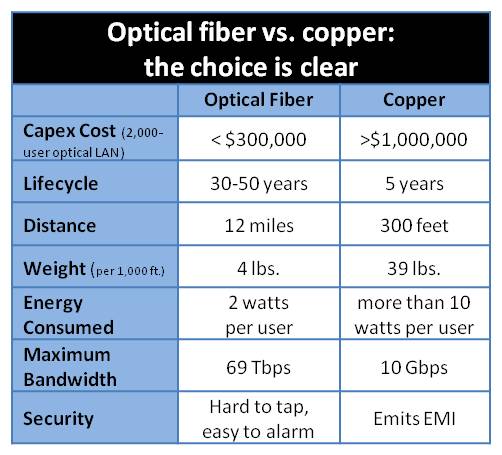Why is Fiber Optic Cable a Better Choice Than Copper Cable?
Nowadays, you can see fiber optics is deployed in many industries, most notably in telecommunications and computer networks. As a result, fiber optic cable is widely used. On the contrast, the utilization of copper cable declines. And as the construction of fiber optics develops further, some entrepreneurs even announced that fiber optic cable will replace copper cables. In spite that these words are not authoritative and unbelievable, we still can see the prospect of fiber optic cable is excellent. So here comes the question: Why is fiber optic cable a better choice than copper cable?
Fiber optic cable is a cable containing one or more optical fibers that are used to carry light. (And it should be differentiated from fiber optic patch cord which consists of a short length of optical fiber with a connector on both ends. For example, LC fiber optic cable, one kind of fiber optic patch cord, consists of optical fiber with a connector whose type is LC.) Commonly, fiber optic cable can be divided into single-mode fiber and multi-mode fiber. Single-mode fiber cable sends signals with laser light, while multi-mode fiber sends signals with light-emitting diodes or LEDs. The thickness and diameter of multi-mode cable are bigger than the single-mode cable’s.
Copper cable is a cable made by copper medium. In copper networks, copper cable is the key component which can be divided into three sub-types: unshielded twisted pair (UTP), screened twisted pair (F/UTP) and shielded twisted pair (S/FTP). And the main medium of signal transmission in copper cable is twisted pair.
There are some aspects that can show fiber optic cable is a better choice than copper cable. And in order to give you a visual description, here is a table below of the comparison of fiber optic cable and copper cable so that you can know it clearly. Also, we will talk about some relative importance of these points in detail.

Higher carrying capacity and wider transmission band: Optical fibers are thinner than copper wires, so more fibers can be bundled into a given-diameter cable than copper wires, allowing more phone lines to go over the same cable or more channels to come through the cable into your business or home. The bandwidth of fiber optics can be up to 50000GHz. For instance, optical fiber system with speed of 2.4Gb/s can transmit more than 3000 phone lines at the same time.
Less signal degradation: The loss of signal in optical fiber is less than in copper wire. Recently, the attenuation of optical fiber is declined to 0.2dB/KM. Therefore, the distance of signal transmission can be longer, even more than a few hundred kilometers because of less attenuation. And also, because the signals degrade less, it can use low power transmitter to transmit signals instead of the high-voltage electrical transmitters needed for copper wires so that it can save some cost.
Light signals: In fiber optic cables, light signals from one fiber do not interfere with those of other fibers in the same cable, which is greatly different from the electric signals in copper cables. This feature means there would be a clearer phone conversation or TV reception using fiber optic cables.
At present, there is point we should admit that copper cable shares most parts of the market. But with so many advantages over copper cable, we strongly believe that fiber optic cable will have a bright future.
Originally published at http://www.chinacablesbuy.com/why-is-fiber-optic-cable-a-better-choice-than-copper-cable.html

Comments